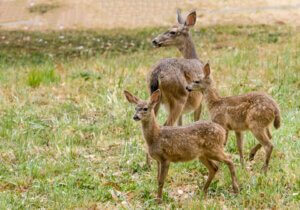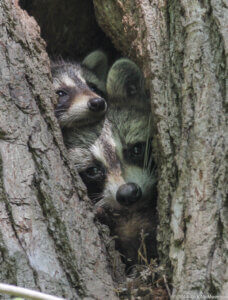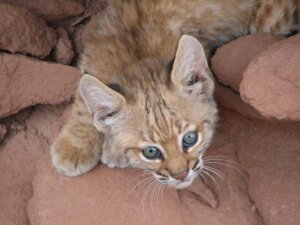Baby Boom
Meet the park’s next-gen kits, kittens, pups, and fawns.
A snub-nose, sun-dappled fawn peering out from the underbrush. Waddling raccoon kits, looking every bit like animated stuffed animals. A tumbling and yipping passel of fuzzy coyote pups, and milky-eyed bobcat kittens, mewing in their moss-lined den.
Babies are everywhere at China Camp right now. Here’s a little info about some of the larger mammal babies out there right now. If you’re lucky enough to spy one of our youngest park residents, post photos or videos on social media, and add the hashtags #chinacampstatepark and #friendsofchinacamp. But remember: all wild animals should be left alone, and parents may be aggressive, so give babies a wide berth for your sake, and theirs.
Black-tailed deer
 With their sprinkling of spots, cartoon-big eyes, and clown-like noses, the young of our largest mammal, can’t help but make you go “Awwwwww.” What’s more, black-tailed deer fawns typically come in pairs for twice as much adorableness.
With their sprinkling of spots, cartoon-big eyes, and clown-like noses, the young of our largest mammal, can’t help but make you go “Awwwwww.” What’s more, black-tailed deer fawns typically come in pairs for twice as much adorableness.
Female deer, or does, often leave their speckled fawns alone for much of the day, with the youngsters instinctively lying still and quiet until their mother returns. If you find a young fawn alone, fear not—it’s likely not abandoned, just hiding until mom returns. Gangly fawns grow quickly, losing their spots after three to four months, and sticking with mom for about a year.
Raccoons
 These masked bandits of the wilderness, raccoons are also extremely adaptable in urbanized areas. So it’s no surprise that these curious and intelligent omnivores often rear their young under buildings or other structures—including buildings at China Camp.
These masked bandits of the wilderness, raccoons are also extremely adaptable in urbanized areas. So it’s no surprise that these curious and intelligent omnivores often rear their young under buildings or other structures—including buildings at China Camp.
After a two-month gestation period, female raccoons typically have three to seven blind and helpless young in early spring. Kits hang with mom at first, heading out to forage with her after a few months, and staying together as a young family through the first winter, when the cycle starts again.
Coyotes
 With their dens usually tucked away in a secluded spot, coyotes do a great job of protecting their pups. Choosing a hollowed-out tree stump, rocky outcropping, dense bushes, or even digging a burrow, these highly intelligent and social carnivores rear their pups as a team, with subordinate coyotes in the pack helping the new parents, typically the alpha male and female.
With their dens usually tucked away in a secluded spot, coyotes do a great job of protecting their pups. Choosing a hollowed-out tree stump, rocky outcropping, dense bushes, or even digging a burrow, these highly intelligent and social carnivores rear their pups as a team, with subordinate coyotes in the pack helping the new parents, typically the alpha male and female.
After breeding in February, females give birth in April. While litter size is typically four to seven pups, coyotes are able to adjust their litter sizes based on food abundance and population density. After several weeks in the den, pups venture out so that by the end of summer, they may start exploring—and even hunting—on their own or with siblings.
Bobcats
 These wild cats thrive in Marin, and, while they tend to be secretive, they are spotted in the park and in adjacent neighborhoods. (Thank you, Ring cameras and NextDoor.) Bobcats typically mate in winter. The female finds a den in a hollow tree or other protected space, which she lines with soft moss and leaves. After 60 days or so, the female births two to four blind furballs, which she nurses and tends solo for about two months.
These wild cats thrive in Marin, and, while they tend to be secretive, they are spotted in the park and in adjacent neighborhoods. (Thank you, Ring cameras and NextDoor.) Bobcats typically mate in winter. The female finds a den in a hollow tree or other protected space, which she lines with soft moss and leaves. After 60 days or so, the female births two to four blind furballs, which she nurses and tends solo for about two months.
Eventually their milky-blue eyes open (eyes darken as bobcats mature). By summer, they are venturing out into the world, learning how to survive from mom before going off on their own by winter.—by Harriot Manley

